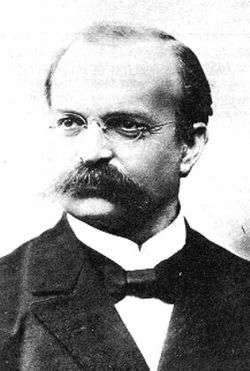Ernst Hartwig
Carl Ernst Albrecht Hartwig (14 January 1851 in Frankfurt – 3 May 1923 in Bamberg) was a German astronomer.

Carl Ernst Albrecht Hartwig
He discovered a new star in M31 (the "Andromeda Nebula") on 20 August 1885. This object was designated as supernova "S Andromedae". He observed the 1882 transit of Venus in Argentina.[1] During the 1883 observation campaign of comet 6P/d'Arrest he found five NGC objects working at the Strasbourg Observatory. In 1874 he became assistant at Strassburg Observatory, 1884 astronomer at Dorpat Observatory and 1887 director of Bamberg Observatory.
The French Academy of Sciences awarded him the Prix Valz in 1902 for his heliometer observations and work on variable stars.[2][3] Craters on the Moon and on Mars were named in his honor.
References
- Hockey, Thomas (2009). The Biographical Encyclopedia of Astronomers. Springer Publishing. ISBN 978-0-387-31022-0. Retrieved August 22, 2012.
- "Séance du 22 décembre". Le Moniteur Scientifique du Doctor Quesneville: 139. February 1903.
- "Notes". The Journal of the British Astronomical Association (3): 143–144. 1903.
External links
- Short biography
- Additional data on page 21
- Neue Deutsche Biographie (in German)
- E. Hartwig @ Astrophysics Data System
Obituary
- AN 219 (1923) 185/186 (in German)
This article is issued from Wikipedia. The text is licensed under Creative Commons - Attribution - Sharealike. Additional terms may apply for the media files.